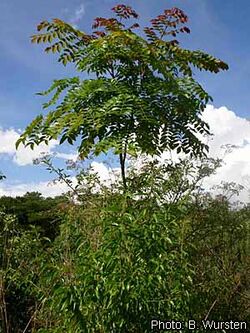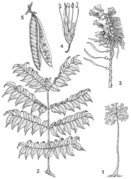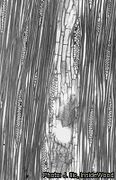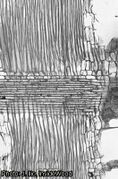Acrocarpus fraxinifolius
Jump to navigation
Jump to search
Acrocarpus fraxinifolius
Wight ex Arn.
| Order | Fabales |
|---|---|
| Family | Fabaceae |
| Genus | Acrocarpus |
2n = 24
Origin : tropical Asia
wild and planted
| English | pink cedar tree |
|---|
Uses summary
- timber
- fire wood, charcoal
- pulp for paper
- ornamental
- forage
- source of nectar for bees
- reinforcing river banks
- shade tree (coffee, tea)
- windbreak
Description
-
1, tree habit; 2, leaf; 3, inflorescence; 4, flower; 5, fruit. Source: PROSEA
-
wood in transverse section
-
wood in tangential section
-
wood in radial sections
Popular names
| English | pink cedar tree, Indian ash, shingle tree (PROTA); red cedar (Mansfeld) |
| French | |
| India | konné, kurangan, mandling (Mansfeld) |
| Bengal | mandania (Mansfeld) |
| Malaysia | karingodi (Mansfeld) |
| Burma | mayahnin, yedama (Mansfeld) |
| Java | delimas (Mansfeld) |
| Sumatera | madang pariek (Mansfeld) |
Classification
Acrocarpus fraxinifolius Wight ex Arn. (1838)
History
Uses
Cultivated as a shade tree for coffee plantations (India) and tea plantations (Sumatra, Java). Also in Africa (Cameroon, Tanzania, Malawi, Nigeria, Zimbabwe, Zambia) sometimes cultivated. The wood is utilized in the manufacture of shingles, tea boxes, furniture and for building purposes.
Mansfeld.




